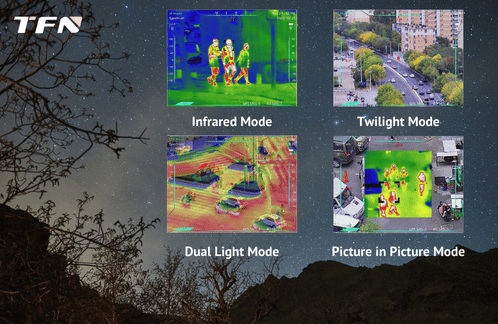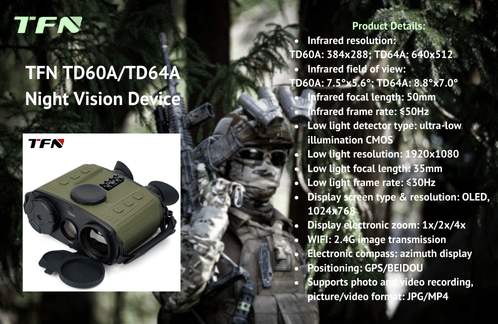Advantages of CMOS image sensors in infrared night vision devices
Infrared night vision devices use infrared radiation to observe and record objects in the environment. The principle is to use infrared sensors to sense infrared radiation in the environment, and then process and amplify electronic signals, and finally display them using a display. In a dark environment, objects usually emit weak infrared radiation, which can be detected by infrared night vision devices and converted into visible images. This makes it possible to see objects in a dark environment.

CMOS (Complementary Metal Oxide Semiconductor) image sensor is a typical solid-state imaging sensor that integrates the image acquisition unit and the signal processing unit on the same chip. CMOS image sensors are usually composed of image sensitive unit array, row driver, column driver, timing control logic, AD converter, data bus output interface, control interface and other parts, which are usually integrated on the same silicon chip. Its workflow is divided into the following steps:
1. External light irradiates the pixel array, photoelectric effect occurs, and corresponding charges are generated in the pixel unit
2. Select the pixel you want to operate through the row selection circuit and column selection circuit, and read the electrical signal on the pixel
3. Perform signal processing on the corresponding pixel unit
CMOS image sensors are increasingly used in infrared night vision devices. CMOS has the characteristics of high sensitivity, low power consumption and fast response, so it performs particularly well in night vision technology. The following are the specific applications and advantages of CMOS in infrared night vision devices:
1. High sensitivity: Modern CMOS image sensors can still maintain high image quality in low-light environments, which is particularly important for infrared night vision devices. Infrared night vision devices usually need to work in complete darkness or extremely low light conditions. The high sensitivity of CMOS sensors enables them to make full use of weak infrared light.
2. Low power consumption: CMOS technology has lower power consumption than other image sensor technologies (such as CCD). This has an important impact on the battery life of portable night vision devices, allowing the devices to work longer in the wild or away from power sources.
3. Low illumination: Low-illumination CMOS can identify very dark light, which can be converted into visible digital signals and displayed on the LCD screen inside the night vision device.
4. Integrated circuits and miniaturization: Since CMOS sensors can share the same silicon substrate with other circuits, they have advantages in size and weight. Smaller size and weight make night vision devices more portable and convenient for adding other functional modules.
5. High-speed response and high frame rate: CMOS sensors have high readout speed and frame rate, which is very useful for capturing dynamic scenes. In actual night vision applications, high frame rate can improve the detection ability and image quality of moving targets.
6. Infrared spectral response: Many modern CMOS sensors are specially designed and optimized to respond well to the infrared spectral range (especially the near-infrared band). This property makes them particularly suitable for night vision applications, capable of capturing images illuminated by infrared LEDs or infrared lasers.
7. Cost and yield: The manufacturing process of CMOS sensors is mature and suitable for large-scale mass production, with lower costs than CCD sensors. This makes night vision devices economically advantageous in both the civilian and military markets.
The application of CMOS image sensors in infrared night vision devices not only improves the performance and reliability of the equipment, but also reduces the manufacturing cost and power consumption of the equipment, promoting the widespread popularization and application of night vision technology.
TFN infrared night vision devices have multiple models that support ultra-low illumination CMOS detectors, infrared mode, low light mode, dual light fusion and picture-in-picture four major modes, which can observe, take pictures and record videos of targets day and night, and are widely used in various occasions such as patrol, law enforcement, anti-smuggling, drug control, forest fire prevention, emergency search and rescue and military reconnaissance.

TFN TD60A & TD64A & TD70B
TD60A |
TD64A |
TD70B |
|
Resolution |
384x288 |
640x512 |
384x288 |
Field of view |
7.5°x5.6° |
8.8°x7.0° |
7.5°x5.6° |
Detection distance - people |
3333 meters |
4722 meters |
3333 meters |
Recognition distance - people |
833 meters |
1180 meters |
833 meters |
WIFI |
Support |
||
Electronic compass |
Azimuth display |
||
Positioning |
GPS/Beidou |
||
Storage |
16G |
||
Photographing |
Support |
||
Video recording |
Support |
||
Rangefinder function |
Don’t Support |
Don’t Support |
2500m rangefinder |
Battery capacity |
2000mAh x 4 (18650 battery) |
||
Battery life |
≥6 hours |
≥6 hours |
≥4 hours |
Operating temperature |
-20℃~+50℃ |
||
Storage temperature |
-30℃~+70℃ |
||
Waterproof level |
IP54 |
||
Product size |
192.8mm x 86.9mm x 189.6mm |
||
Product weight |
1.58KG(include battery) |
||
If you are interested in TFN infrared night vision devices, please contact TFN sales team:
Email: info@tfngj.com
WhatsApp: +86-18765219251
Facebook: https://www.facebook.com/tfnfate/
